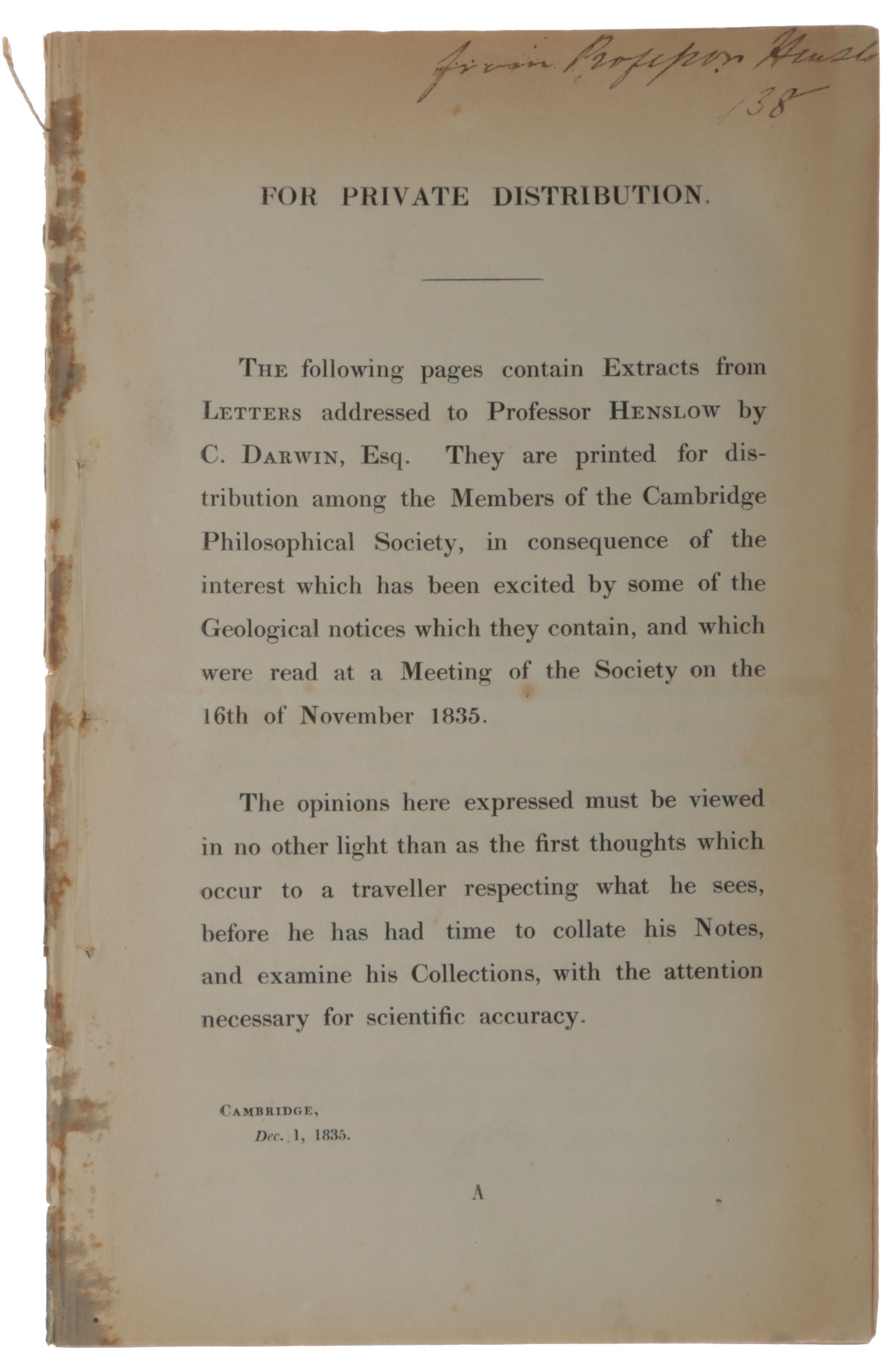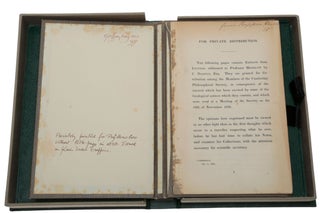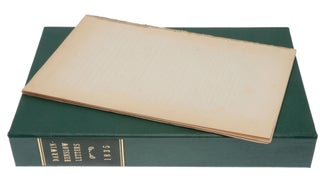For Private Distribution. The following pages contains extracts from Letters addressed to Professor Henslow by C. Darwin, Esq. They are printed for distribution among the members of the Cambridge Philosophical Society …
Cambridge: [the University Press for the Cambridge Philosophical Society, 1835. First edition, very rare, inscribed by John Stevens Henslow, of Darwin’s first separately printed work and his first account in print of his discoveries on the Beagle. “During his five-year voyage on HMS Beagle, Darwin maintained a correspondence with John Stevens Henslow, his mentor in natural history and lifelong friend; it was Henslow who had obtained for Darwin the post of ship’s naturalist on the Beagle. The present pamphlet contains extracts made by Henslow from ten of Darwin’s letters” (Norman). Henslow had this pamphlet printed without Darwin's knowledge for distribution amongst the members of the Cambridge Philosophical Society “in consequence of the interest which has been excited by some of the Geological notices which they contain, and which were read at a Meeting of the Society on the 16th of November 1835” (p. [1]), an act which secured Darwin’s reputation with the scientific community even before his return to England in October, 1836. Freeman states that ‘it has always been assumed that it was issued … in December 1835, and this is probably so, but I have not seen a copy with a dated ownership inscription or accession stamp for that year.’ The pamphlet was printed without Darwin’s knowledge; when he learned of it he confessed himself ‘a good deal horrified’ at Henslow making public ‘what had been written without care or accuracy … but, as the Spaniard says, ‘No hay remedio’’” (Barlow (ed.), Charles Darwin and the Voyage of the Beagle, pp. 140-142)” (Norman). “Darwin, however, was mollified when he learned from his sister that the booklet had been well received and that Henslow had told the Darwin family that young Charles would surely be placed ‘among the first naturalists of the day.’ He was particularly gratified to learn that his father, who had had doubts about Charles’s decision to pursue a career in natural history, ‘did not move from his seat till he had read every word of your book … he liked so much the simple clear way you gave information’” (Gibson, The Spirit of Inquiry: How one extraordinary society shaped modern science, pp. 89-90). “Despite Henslow’s reservations about the evolutionary ideas put forward in Origin – he thought Darwin had ‘pressed his hypothesis too far’ – the two men remained friends to the end of Henslow's life; more than 140 letters between them survive. Darwin continued to rely on Henslow for information on a variety of plants, and wrote of him after his death ‘a better man never walked this earth’” (Darwin Correspondence Project). A proof copy with some twenty corrections in pencil was sold by Sotheby’s on 13 March 1973 (lot 404), and since then only four other copies have sold at auction, including a copy presented by Henslow to Oxford’s Ashmolean Natural History Society. Provenance: Inscribed at the head of the first page ‘from Professor Henslo[w] / [18]38’; Sir Geoffrey Keynes, surgeon and bibliophile (1887-1982), ownership inscription on folding case dated 1937; his son (and Charles Darwin’s great-grandson), Prof. Richard Keynes (1919-2010), physiologist and Darwin scholar. “Darwin came to know Henslow through his attendance at his scientific talks and outings at Cambridge University. He had heard of Henslow through his brother Erasmus who greatly revered him as a man of scientific brilliance and integrity. Inspired by Henslow he soon became a visitor to Henslow’s house and subsequently met the scientific fraternity. “The British Admiralty Hydrographer of the Navy, Francis Beaufort, was part of the Cambridge network, and keen to promote science. When organising the second survey voyage of HMS Beagle, he took up captain Robert FitzRoy’s suggestion of taking along a geologist, and asked his friend the mathematician George Peacock to ‘recommend a proper person to go out as a naturalist with this expedition.’ Peacock offered the place to the Reverend Leonard Jenyns, who got as far as packing his clothes before having second thoughts. Henslow thought of going, but his wife ‘looked so miserable’ that he turned it down. “Henslow obviously rated Darwin highly, though at the time science was not a formally recognised subject at Cambridge. Henslow replied to Peacock that Darwin was ‘the best qualified person I know of who is likely to undertake such a situation’, and then wrote a letter to Darwin who was then on a field trip in Wales studying practical geology with Adam Sedgwick (Professor of Geology). When Darwin returned to Shrewsbury on 29 August 1831 he found the letter from Henslow telling him of the offer. His father was opposed to the idea, so Darwin turned it down, but his uncle overcame the objections, and on 1 September Darwin accepted the self-funded position. “Preparations were quickly made. Darwin insisted that his collections would be under his own control, subject to them going to a suitable public body. Henslow had hopes for the small Cambridge Philosophical Society museum, but Darwin diplomatically said new finds should go to the ‘largest & most central collection’ rather than a ‘Country collection, let it be ever so good.’ FitzRoy arranged transport of specimens to England by the Admiralty Packet Service, and Henslow agreed to store them at Cambridge. Darwin confirmed with him arrangements for land carriage from the port. “After delays, the Beagle set off on 27 December 1831. They visited Atlantic islands, then reached South America on 4 April 1832. Darwin, delighted by his geological findings, collections of organisms and by the sights of the tropics, waited until they were at Rio de Janeiro to write the first of a series of letters to Henslow. “Extracts were taken from ten letters: “From Lima, Darwin wrote on 12 August 1835 that another excursion had changed his ideas about the Cordillera formations, and he was soon going to the Galapagos Islands, but Henslow did not include excerpts, probably this letter arrived too late. “Henslow compiled quotes from ten letters, and minutes of the 16 November 1835 meeting of the Cambridge Philosophical Society, chaired by the president, Rev. Dr William Clark, record that: ‘Extracts were read of letters from C. Darwin Esq. of Christ's College containing accounts of the Geology of certain parts of the Andes and S. America. Observations by Prof. Sedgwick and Henslow.’ “At the 18 November meeting of the Geological Society of London, Sedgwick read geological notes based on the letters. After noting that the letters contained ‘a very great mass of information connected with almost every branch of natural history’, he ‘had selected for the occasion those remarks only which he thought more especially interesting to the Geological Society.’ He summarised Darwin’s reports, and ‘concluded by reading extracts from two letters describing a section transverse to the Andes’. “The Athenæum magazine of 21 November reported that Sedgwick ‘read extracts from letters addressed by Mr. Darwin to Professor Henslow— They referred principally to the writers observations on the tertiary formation of Patagonia & Chili & on the changes of level between land & sea, which he noticed in these countries. The letters also contained an accnt of his discovery of the remains of the Megatherium over a district of 600 miles in extent to the Southwd of Buenos Ayres & a highly important description of the Geological structure of the Pass of Upsallata, in the Andes, where he discovered alternations of vast tertiary & igneous formations & the existence in the former, of veins of true granite, & of gold & other metals’ (transcribed by Darwin's sister Caroline). “Darwin's sister Susan wrote to him on 22 November, and mentioned that their brother Eras had heard that ‘some of your Letters were read at the Geological Society in London & were thought very interesting’. In addition, they had seen part of a letter from Sedgwick telling Dr. Butler that Darwin, his former student, was ‘doing admirably in S. America,’ and though there had been ‘some risk of his turning out an idle man’ he would now ‘have a great name among the Naturalists of Europe.’ “On 30 November the Council of the Cambridge Philosophical Society decided, as minuted, that ‘The printing of certain extracts from Mr Darwin's correspondence be submitted to Mr Whewell, Mr Peacock & Prof. Henslow.’ “The pamphlet is headed ‘For Private Distribution’. Its preface, dated 1 December 1835, reads ‘They are printed for distribution among the Members of the Cambridge Philosophical Society, in consequence of the interest which has been excited by some of the Geological notices which they contain’. A disclaimer [by Henslow] states: ‘The opinions here expressed must be viewed in no other light than as the first thoughts which occur to a traveller respecting what he sees, before he has had time to collate his Notes, and examine his Collections, with the attention necessary for scientific accuracy.’ “Henslow sent some copies of the pamphlet to Darwin’s father, with a note rejoicing that Darwin would soon be back to take a ‘position among the first Naturalist of the day’, delivered on 25 December. According to Darwin’s sister Caroline their father ‘did not move from his seat till he had read every word of your book & he was very much gratified—he liked so much the simple clear way you gave your information Your frank unhacknied mode of writing was to him particularly agreeable’. Their father wrote thanking Henslow with the comment that ‘There is a natural good humored energy in his letters just like himself’, and gave copies of the pamphlet to friends and relatives. On 29 December Caroline wrote to tell her brother the news. “On 29 January 1836 their sister Catherine wrote with more family news, noting they had sent their cousin William Fox ‘one of the little books, with the Extracts from your Letters; every body is much pleased, with them, who has seen them; Professor Henslow sent half a dozen’ to Dr. Butler, who had been headmaster when Darwin was at the Shrewsbury School. “Darwin only heard about all this after Beagle reached the Cape of Good Hope on 31 May 1836. In Cape Town, he received the letter dated 29 January from his sister Catherine which briefly mentioned, ‘We have sent William Fox one of the little books, with the Extracts from your Letters; every body is much pleased, with them, who has seen them; Professor Henslow sent half a dozen to Dr Butler; we sent one also to Tom Eyton;—he says he has written to you at Sydney, so you will have his opinion from himself of them.’ Darwin replied, ‘I have been a good deal horrified by a sentence in your letter where you talk of 'the little books with the extracts from your letters'. I can only suppose they refer to a few geological details. But I have always written to Henslow in the same careless manner as to you; & to print what has been written without care & accuracy, is indeed playing with edge tools. But as the Spaniard says, ‘No hay remedio’.’ “Some earlier letters caught up with the ship when it reached Ascension Island on 19 July, including the November letter from his sister Susan. Darwin was delighted at the news, particularly Sedgwick’s comment about ‘a great name among the Naturalists of Europe’, and later recalled having then ‘clambered over the mountains … with a bounding step and made the volcanic rocks resound under my geological hammer!’” (Wikipedia, accessed 6 April, 2022). Freeman 1; Norman 583.
8vo (215 x 137mm.), pp. [1-3], 4-31, [1, blank] (leaves slightly browned with minor occasional spotting, remains of original pale grey plain wrappers to spine and first and final leaves, three stab holes from previous binding). Disbound, housed within tan buckram folding case.
Item #5657
Price: $450,000.00




